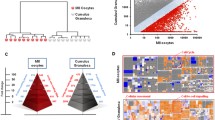Abstract
Long noncoding RNAs (lncRNAs), which are prevalently transcribed in the genome, are involved in a variety of biological functions, yet little is known about their abundance in human cumulus cells (CCs) during oocyte development. Here, we describe the expression profile of lncRNAs in 3 pairs of cumulus cells from mature oocytes that result in high-quality embryo (H-CCs) and from oocytes that result in poor-quality embryo (P-CCs) using microarray analysis. In this study, a total of 20 563 lncRNAs were expressed in human CCs. One hundred and twenty four lncRNAs were consistently upregulated, and 509 lncRNAs were consistently downregulated in all samples analyzed (fold change ≥ 2.0, P < .05). Quantitative real-time polymerase chain reaction (qRT-PCR) was used to validate 5 upregulated and 7 downregulated lncRNAs. The qRT-PCR results in the study were confirmed to be consistent with the microarray results. Network analysis was used for further research. The results displayed the differentially expressed lncRNAs in P-CCs between H-CCs, which suggested that lncRNAs may contribute to the processes of oocyte and early embryo development.
Similar content being viewed by others
References
Steer CV, Mills CL, Tan SL, Campbell S, Edwards RG. The cumulative embryo score: a predictive embryo scoring technique to select the optimal number of embryos to transfer in an in-vitro fertilization and embryo transfer programme. Hum Reprod. 1992; 7(1):117–119.
Ebner T, Yaman C, Moser M, Sommergruber M, Feichtinger O, Tews G. Prognostic value of first polar body morphology on fertilization rate and embryo quality in intracytoplasmic sperm injection. Hum Reprod. 2000;15(2):427–430.
Krisher RL. The effect of oocyte quality on development. J Anim Sci. 2004;82(E suppl):E14–E23.
Russell DL, Robker RL. Molecular mechanisms of ovulation: co-ordination through the cumulus complex. Hum Reprod Update. 2007;13(3):289–312.
Su YQ, Sugiura K, Eppig JJ. Mouse oocyte control of granulosa cell development and function: paracrine regulation of cumulus cell metabolism. Semin Reprod Med. 2009;27(1):32–42.
Matzuk MM, Burns KH, Viveiros MM, Eppig JJ. Intercellular communication in the mammalian ovary: oocytes carry the conversation. Science. 2002;296(5576):2178–2180.
McKenzie LJ, Pangas SA, Carson SA, et al. Human cumulus granulosa cell gene expression: a predictor of fertilization and embryo selection in women undergoing IVF. Hum Reprod. 2004;19(12):2869–2874.
Zhang X, Jafari N, Barnes RB, Confino E, Milad M, Kazer RR. Studies of gene expression in human cumulus cells indicate pentraxin 3 as a possible marker for oocyte quality. Fertil Steril. 2005;83(suppl 1):1169–1179.
Ponting CP, Oliver PL, Reik W. Evolution and functions of long noncoding RNAs. Cell. 2009;136(4):629–641.
Guttman M, Amit I, Garber M, et al. Chromatin signature reveals over a thousand highly conserved large non-coding RNAs in mammals. Nature. 2009;458(7235):223–227.
Schonrock N, Harvey RP, Mattick JS. Long noncoding RNAs in cardiac development and pathophysiology. Circ Res. 2012; 111(10):1349–1362.
Brosnan CA, Voinnet O. The long and the short of noncoding RNAs. Curr Opin Cell Biol. 2009;21(3):416–425.
Assou S, Al-edani T, Haouzi D, et al. MicroRNAs: new candidates for the regulation of the human cumulus–oocyte complex. Hum Reprod. 2013;28(11):3038–3049.
Hossain MM, Salilew-Wondim D, Schellander K, Tesfaye D. The role of microRNAs in mammalian oocytes and embryos. Anim Reprod Sci. 2012;134(1–2):36–44.
Wang KC, Chang HY. Molecular mechanisms of long noncoding RNAs. Mol Cell. 2011;43(6):904–914.
Mercer TR, Dinger ME, Mattick JS. Long non-coding RNAs: insights into functions. Nat Rev Genet. 2009;10(3):155–159.
Xu X, Chen D, Zhang Z, Wei Z, Cao Y. Molecular signature in human cumulus cells related to embryonic developmental potential [published online 2014 Jun 4]. Reprod Sci. 2014.
Polan ML, Warrington JA, Chen B, Mahadevappa M, Wang H, Wen Y. Bench to bedside: clinical opportunities for microarray analysis. Fertil Steril. 2003;80(2):291–292.
Ponting CP, Oliver PL, Reik W. Evolution and functions of long-noncoding RNAs. Cell. 2009;1364:629–641.
Im JH, Muschel RJ. New evidence of IncRNA role in tumor progression and metastasis. Hepatobiliary Surg Nutr. 2012;1(1):55–56.
Lai MC, Yang Z, Zhou L, et al. Long non-coding RNA MALAT-1 overexpression predicts tumor recurrence of hepatocellular carcinoma after liver transplantation. Med Oncol. 2012;29(3): 1810–1816.
Ebisuya M, Yamamoto T, Nakajima M, Nishida E. Ripples from neighbouring transcription. Nat Cell Biol. 2008;10(9): 1106–1113.
Sproul D, Gilbert N, Bickmore WA. The role of chromatin structure in regulating the expression of clustered genes. Nat Rev Genet. 2005;6(10):775–781.
Yissachar N, Salem H, Tennenbaum T, Motro B. Nek7 kinase is enriched at the centrosome, and is required for proper spindle assembly and mitotic progression. FFBS Lett. 2006;580(27): 6489–6495.
Salem1 H, Rachmin I, Yissachar N, et al. Nek7 kinase targeting leads to early mortality, cytokinesis disturbance and polyploidy. Oncogene. 2010;29(28):4046–4057.
Ishak SD, Tan SH, Khong HK, et al. Upregulated mRNA expression of desaturase and elongase, two enzymes involved in highly unsaturated fatty acids biosynthesis pathways during follicle maturation in zebrafish. Reprod Biol Endocrinol. 2008;24(6):56.
Tahara D, Yano I. Maturation-related variations in prostaglandin and fatty acid content of ovary in the kuruma prawn (Marsupenaeus japonicus). Comp Biochem Physiol A Mol Integr Physiol. 2004;137(4):631–637.
Author information
Authors and Affiliations
Corresponding author
Rights and permissions
About this article
Cite this article
Xu, XF., Li, J., Cao, YX. et al. Differential Expression of Long Noncoding RNAs in Human Cumulus Cells Related to Embryo Developmental Potential: A Microarray Analysis. Reprod. Sci. 22, 672–678 (2015). https://doi.org/10.1177/1933719114561562
Published:
Issue Date:
DOI: https://doi.org/10.1177/1933719114561562




